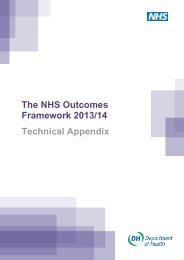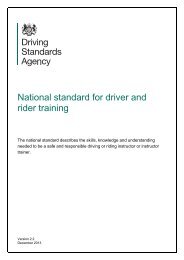Decontamination in primary care dental practices - Gov.uk
Decontamination in primary care dental practices - Gov.uk
Decontamination in primary care dental practices - Gov.uk
You also want an ePaper? Increase the reach of your titles
YUMPU automatically turns print PDFs into web optimized ePapers that Google loves.
<strong>Decontam<strong>in</strong>ation</strong>: Health Technical Memorandum 01-05 – <strong>Decontam<strong>in</strong>ation</strong> <strong>in</strong> <strong>primary</strong> <strong>care</strong> <strong>dental</strong> <strong>practices</strong> (2013 edition)Benchtop sterilizers4.9 Benchtop sterilizers should be operated to ensurethat:• they are compliant with the safety requirementsstated <strong>in</strong> this guidance and <strong>in</strong> the manufacturer’snotes;• they are <strong>in</strong>stalled, commissioned, validated andma<strong>in</strong>ta<strong>in</strong>ed appropriately <strong>in</strong> compliance withthe manufacturer’s <strong>in</strong>structions (see Section 3);• they are operated <strong>in</strong> accordance with theequipment manufacturer’s <strong>in</strong>structions.Pre-wrap <strong>in</strong>struments only where this isrecommended by the manufacturer and wherethe sterilizer is vacuum-assisted. The sterilizershould be validated for the <strong>in</strong>tended load and islikely to be of type B or S. The use of a type Nsterilizer is not appropriate for wrapped<strong>in</strong>struments.4.10 All steam sterilizers are subject to the PressureSystems Safety Regulations 2000 and must beexam<strong>in</strong>ed periodically by a Competent Person(Pressure Vessels).Use and test<strong>in</strong>g of benchtop sterilizers4.11 To ensure the safety of this device, the follow<strong>in</strong>gpo<strong>in</strong>ts should be adhered to:1. Each sterilizer will have a reservoir chamberfrom which the water is delivered for steamgeneration. This should be filled, at least daily,us<strong>in</strong>g distilled or RO water. However, morefrequent dra<strong>in</strong><strong>in</strong>g and refill<strong>in</strong>g offers qualityadvantages <strong>in</strong> terms of the appearance andsuitability of the f<strong>in</strong>ished <strong>in</strong>struments. At theend of the work<strong>in</strong>g day, the device should thenbe cleaned, dried, and left empty with the doorkept open. For s<strong>in</strong>gle-shot types, which do notstore water between cycles of use, these rules stillapply <strong>in</strong> terms of the water quality to be used.2. Validation is necessary to demonstrate that thephysical conditions required for sterilization(temperature, pressure, time) are achieved.Consultation with appropriately qualifiedeng<strong>in</strong>eers will be necessary. A Competent Person(<strong>Decontam<strong>in</strong>ation</strong>) or service eng<strong>in</strong>eer will beable to ensure that validation is achieved andthat the <strong>in</strong>strumentation used for parametricrelease is function<strong>in</strong>g and calibratedappropriately. The Competent Person(<strong>Decontam<strong>in</strong>ation</strong>) or service eng<strong>in</strong>eer will beneeded to validate or revalidate the equipment(see Section 3).Parametric release is def<strong>in</strong>ed as the release of a batchof sterilized items based on data from the sterilizationprocess. All parameters with<strong>in</strong> the process have to bemet before the batch can be released for use.3. Test<strong>in</strong>g is an <strong>in</strong>tegral part of ensur<strong>in</strong>g thata benchtop sterilizer consistently performs tooperat<strong>in</strong>g parameters set dur<strong>in</strong>g the mach<strong>in</strong>e’scommission<strong>in</strong>g. Failure to carry out rout<strong>in</strong>eperiodic tests and ma<strong>in</strong>tenance tasks couldcompromise safety and have legal and<strong>in</strong>surance-related implications for the RegisteredManager (see paragraph 9.3).4. A schedule for periodic test<strong>in</strong>g should thereforebe planned and performed <strong>in</strong> accordance withSection 3. The schedule should provide detailsof daily, quarterly and yearly test<strong>in</strong>g or be <strong>in</strong>accordance with manufacturers’ guidel<strong>in</strong>es.Each sterilizer should have a logbook (file) <strong>in</strong>which details of the follow<strong>in</strong>g are recorded:• ma<strong>in</strong>tenance;• validation;• faults;• modifications;• rout<strong>in</strong>e tests (see Appendix 2).4.12 Health Service Circular (HSC) 1999/053 and thesubsequent ‘Records management: code of practiceparts 1 and 2’ (April 2006) provide guidance onthe length of time for which records should bereta<strong>in</strong>ed. Reference should be made to the timeperiod of legal rights of patients, and all relevantdocumentation should be reta<strong>in</strong>ed for the practiceto meet any request with<strong>in</strong> these rights. The coderequires that these records be ma<strong>in</strong>ta<strong>in</strong>ed for notless than two years, although longer periods may beapplicable subject to local policy-mak<strong>in</strong>g.4.13 The logbook should conta<strong>in</strong> all <strong>in</strong>formationperta<strong>in</strong><strong>in</strong>g to the lifecycle of the equipment (frompurchas<strong>in</strong>g through to disposal).4.14 If the sterilizer has an automatic pr<strong>in</strong>ter, the pr<strong>in</strong>toutshould be reta<strong>in</strong>ed or copied to a permanentrecord. If the sterilizer does not have a pr<strong>in</strong>ter, theuser will have to manually record the follow<strong>in</strong>g<strong>in</strong>formation <strong>in</strong> the process log:• date;• satisfactory completion of the cycle (absence offailure light);24
















